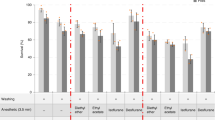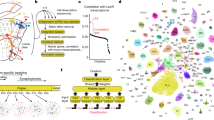Abstract
Cell culture systems are widely used for molecular, genetic and biochemical studies. Primary cell cultures of animal tissues offer the advantage that specific cell types can be studied in vitro outside of their normal environment. We provide a detailed protocol for generating primary neural cell cultures derived from larval brains of Drosophila melanogaster. The developing larval brain contains stem cells such as neural precursors and intermediate neural progenitors, as well as fully differentiated and functional neurons and glia cells. We describe how to analyze these cell types in vitro by immunofluorescent staining and scanning confocal microscopy. Cell type–specific fluorescent reporter lines and genetically encoded calcium sensors allow the monitoring of developmental, cellular processes and neuronal activity in living cells in vitro. The protocol provides a basis for functional studies of wild-type or genetically manipulated primary neural cells in culture, both in fixed and living samples. The entire procedure takes ∼3 weeks.
This is a preview of subscription content, access via your institution
Access options
Subscribe to this journal
Receive 12 print issues and online access
$259.00 per year
only $21.58 per issue
Buy this article
- Purchase on Springer Link
- Instant access to full article PDF
Prices may be subject to local taxes which are calculated during checkout


Similar content being viewed by others
References
Campos-Ortega, J. & Hartenstein, V. The Embryonic Development of Drosophila melanogaster 2nd edn. (Springer, 1997).
Schneider, I. Cell lines derived from late embryonic stages of Drosophila melanogaster. J. Embryol. Exp. Morphol. 27, 353–365 (1972).
Echalier, G. & Ohanessian, A. Isolation, in tissue culture, of Drosophila melangaster cell lines. Serie D: Sciences naturelles 268, 1771–1773 (1969).
Echalier, G. Drosophila Cells in Culture. (Academic Press, 1997).
Dobbelaere, J. et al. A genome-wide RNAi screen to dissect centriole duplication and centrosome maturation in Drosophila. PLoS Biol. 6, e224 (2008).
Mohr, S., Bakal, C. & Perrimon, N. Genomic screening with RNAi: results and challenges. Annu. Rev. Biochem. 79, 37–64 (2010).
Castoreno, A.B. et al. Small molecules discovered in a pathway screen target the Rho pathway in cytokinesis. Nat. Chem. Biol. 6, 457–463 (2010).
Zhang, Y. et al. Expression in aneuploid Drosophila S2 cells. PLoS Biol. 8, e1000320 (2010).
Gonzalez, M. et al. Generation of stable Drosophila cell lines using multicistronic vectors. Sci. Rep. 1, 75 (2011).
Simcox, A. et al. Efficient genetic method for establishing Drosophila cell lines unlocks the potential to create lines of specific genotypes. PLoS Genet. 4, e1000142 (2008).
Donady, J.J. & Seecof, R.L. Effect of the gene lethal (1) myospheroid on Drosophila embryonic cells in vitro. In Vitro 8, 7–12 (1972).
Prokop, A., Kuppers-Munther, B. & Sanchez-Soriano, N. Using primary neuron cultures of Drosophila to analyze neuronal circuit formation and function. in The Making and Un-making of Neuronal Circuits Ch. 10 (ed. Hassan, B.A.) 225–248 (Humana Press, 2012).
Grosskortenhaus, R., Pearson, B.J., Marusich, A. & Doe, C.Q. Regulation of temporal identity transitions in Drosophila neuroblasts. Dev. Cell 8, 193–202 (2005).
Kraft, R. et al. Phenotypes of Drosophila brain neurons in primary culture reveal a role for fascin in neurite shape and trajectory. J. Neurosci. 26, 8734–8747 (2006).
Kraft, R., Levine, R.B. & Restifo, L.L. The steroid hormone 20-hydroxyecdysone enhances neurite growth of Drosophila mushroom body neurons isolated during metamorphosis. J. Neurosci. 18, 8886–8899 (1998).
Seecof, R.L., Teplitz, R.L., Gerson, I., Ikeda, K. & Donady, J. Differentiation of neuromuscular junctions in cultures of embryonic Drosophila cells. Proc. Natl. Acad. Sci. USA 69, 566–570 (1972).
Sicaeros, B., Campusano, J.M. & O'Dowd, D.K. Primary neuronal cultures from the brains of late-stage Drosophila pupae. J. Vis. Exp. 200 (2007).
Luer, K. & Technau, G.M. Single-cell cultures of Drosophila neuroectodermal and mesectodermal central nervous system progenitors reveal different degrees of developmental autonomy. Neural Develop. 4, 30 (2009).
Gu, H. et al. Cav2-type calcium channels encoded by cac regulate AP-independent neurotransmitter release at cholinergic synapses in adult Drosophila brain. J. Neurophysiol. 101, 42–53 (2009).
Su, H. & O'Dowd, D.K. Fast synaptic currents in Drosophila mushroom body Kenyon cells are mediated by α-bungarotoxin–sensitive nicotinic acetylcholine receptors and picrotoxin-sensitive GABA receptors. J. Neurosci. 23, 9246–9253 (2003).
Campusano, J.M., Su, H., Jiang, S.A., Sicaeros, B. & O'Dowd, D.K. nAChR-mediated calcium responses and plasticity in Drosophila Kenyon cells. Dev. Neurobiol. 67, 1520–1532 (2007).
Riemensperger, T., Pech, U., Dipt, S. & Fiala, A. Optical calcium imaging in the nervous system of Drosophila melanogaster. Biochim. Biophys. Acta 1820, 1169–1178 (2012).
Liu, Z., Celotto, A.M., Romero, G., Wipf, P. & Palladino, M.J. Genetically encoded redox sensor identifies the role of ROS in degenerative and mitochondrial disease pathogenesis. Neurobiol. Dis. 45, 362–368 (2012).
Wu, C.F., Suzuki, N. & Poo, M.M. Dissociated neurons from normal and mutant Drosophila larval central nervous system in cell culture. J. Neurosci. 3, 1888–1899 (1983).
Ceron, J., Tejedor, F.J. & Moya, F. A primary cell culture of Drosophila postembryonic larval neuroblasts to study cell cycle and asymmetric division. Eur. J. Cell Biol. 85, 567–575 (2006).
Moraru, M., Egger, B., Bao, D.B. & Sprecher, S.G. Analysis of cell identity, morphology, apoptosis and mitotic activity in a primary neural cell culture system in Drosophila. Neural Develop. 7, 14 (2012).
Berger, C. et al. FACS purification and transcriptome analysis of Drosophila neural stem cells reveals a role for Klumpfuss in self-renewal. Cell Rep. 2, 407–418 (2012).
Tian, L. et al. Imaging neural activity in worms, flies and mice with improved GCaMP calcium indicators. Nat. Methods 6, 875–881 (2009).
Ashburner, M., Golic, K.G. & Hawley, R.S. Drosophila: a Laboratory Handbook 2nd edn. (Cold Spring Harbor Laboratory Press, 2005).
Python, F. & Stocker, R.F. Adult-like complexity of the larval antennal lobe of D. melanogaster despite markedly low numbers of odorant receptor neurons. J. Comparative Neurol. 445, 374–387 (2002).
Park, J.H. et al. Differential regulation of circadian pacemaker output by separate clock genes in Drosophila. Proc. Natl. Acad. Sci. USA 97, 3608–3613 (2000).
Poeck, B., Triphan, T., Neuser, K. & Strauss, R. Locomotor control by the central complex in Drosophila—An analysis of the tay bridge mutant. Dev. Neurobiol. 68, 1046–1058 (2008).
Egger, B., Boone, J.Q., Stevens, N.R., Brand, A.H. & Doe, C.Q. Regulation of spindle orientation and neural stem cell fate in the Drosophila optic lobe. Neural Develop. 2, 1 (2007).
Prokop, A., Bray, S., Harrison, E. & Technau, G.M. Homeotic regulation of segment-specific differences in neuroblast numbers and proliferation in the Drosophila central nervous system. Mech. Dev. 74, 99–110 (1998).
Thacker, S.A., Bonnette, P.C. & Duronio, R.J. The contribution of E2F-regulated transcription to Drosophila PCNA gene function. Curr. Biol. 13, 53–58 (2003).
Langevin, J. et al. Lethal giant larvae controls the localization of notch-signaling regulators numb, neuralized, and Sanpodo in Drosophila sensory-organ precursor cells. Curr. Biol. 15, 955–962 (2005).
Akerboom, J. et al. Optimization of a GCaMP calcium indicator for neural activity imaging. J. Neurosci. 32, 13819–13840 (2012).
Weng, M., Komori, H. & Lee, C.Y. Identification of neural stem cells in the Drosophila larval brain. Methods Mol. Biol. 879, 39–46 (2012).
Acknowledgements
We thank the Bloomington Stock Center, K. Matthews, Y. Bellaiche and L. Looger for fly lines, and the DHSB for antibodies. Special thanks to our colleagues at the Department of Biology, the Institute of Developmental and Cell Biology and the Sprecher lab for helpful discussions. This work was funded by grant no. PP00P3_123339 from the Swiss National Science Foundation to S.G.S., the Novartis Foundation for Biomedical Research to S.G.S. and by the Swiss University Conference (SUK/CUS) to B.E.
Author information
Authors and Affiliations
Contributions
B.E., L.v.G. and M.M. performed the experiments. M.M., B.E., L.v.G. and S.G.S. developed the protocol. B.E. and S.G.S. wrote the paper.
Corresponding author
Ethics declarations
Competing interests
The authors declare no competing financial interests.
Rights and permissions
About this article
Cite this article
Egger, B., van Giesen, L., Moraru, M. et al. In vitro imaging of primary neural cell culture from Drosophila. Nat Protoc 8, 958–965 (2013). https://doi.org/10.1038/nprot.2013.052
Published:
Issue Date:
DOI: https://doi.org/10.1038/nprot.2013.052
This article is cited by
-
Identification of cis-acting determinants mediating the unconventional secretion of tau
Scientific Reports (2021)
-
Multimodal stimulus coding by a gustatory sensory neuron in Drosophila larvae
Nature Communications (2016)
-
Live imaging of axonal transport in Drosophila pupal brain explants
Nature Protocols (2015)
Comments
By submitting a comment you agree to abide by our Terms and Community Guidelines. If you find something abusive or that does not comply with our terms or guidelines please flag it as inappropriate.



